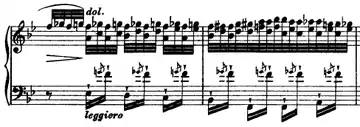Transcendental Études
The Transcendental Études (French: Études d'exécution transcendante), S.139, are a set of twelve compositions for piano by Franz Liszt. They were published in 1852 as a revision of an 1837 set (which had not borne the title "d'exécution transcendante"), which in turn were – for the most part – an elaboration of a set of studies written in 1826.
| Études d'exécution transcendante Transcendental Études | |
|---|---|
| Piano études by Franz Liszt | |
.jpg.webp) Portrait of Liszt (1839) | |
| Catalogue | S.139 |
| Year | 1837 |
| Based on | Étude en douze exercices, S.136 |
| Dedication | Carl Czerny |
| Published | 1852 |
| Movements | 12 |
History

The genesis of the Transcendental Études goes back to 1826, when 15-year-old Liszt wrote a set of youthful exercises called the Étude en douze exercices (Study in twelve exercises), S.136.[1] These pieces were not particularly technically demanding. Liszt then returned to these pieces for thematic ideas, elaborating on them considerably, in the composition of the Douze Grandes Études (Twelve Grand Studies), S.137, which were published in 1837.
The Transcendental Études, S.139, are revisions of the Douze Grandes Études. The fourth was altered and published alone as Mazeppa in late 1846,[2] and the collection as a whole was published in 1852 and dedicated to Carl Czerny,[3] Liszt's piano teacher, and himself a prolific composer of études. The set included simplifications for the most part: in addition to many other reductions, Liszt removed all stretches of intervals greater than a tenth, making the pieces more suitable for pianists with smaller hands. However, some actually consider the fourth étude of the final set, Mazeppa, to be more demanding than its 1837 version, because it is laid out differently, frequently altering and crossing the hands to create a "galloping" effect.
When revising the 1837 set of études into their final "Transcendental" versions, Liszt added programmatic titles in French and German to all but two of the pieces,[3] Études Nos. 2 and 10. Editor Ferruccio Busoni later named those Fusées (Rockets) and Appassionata respectively. Still, others, including music publisher G. Henle Verlag refer to these pieces by their tempo indications, Molto vivace and Allegro agitato molto respectively.[4]
Liszt's original idea was to write 24 études, one in each of the 24 major and minor keys. He completed only half of this project, using the neutral and flat key signatures. In 1897–1905 the Russian composer Sergei Lyapunov wrote his own set of Douze études d'exécution transcendante, Op. 11, continuing Liszt's cycle through the keys that Liszt had not used, namely the sharp keys, to "complete" the set of 24.[5] Lyapunov's set of études was dedicated to the memory of Liszt, and bore titles as Liszt's set had done, with the final étude being entitled Élégie en mémoire de Franz Liszt.
Very few pianists have recorded the 1837 set, and even fewer have recorded the 1826 set (which really are works of Liszt's juvenilia). Leslie Howard is the only pianist to have recorded all three sets on a major label for international release, as part of his series of recordings for Hyperion of the complete solo piano music of Liszt.
Other works with a similar title
- Sergei Lyapunov, 12 Études d'exécution transcendante, Op. 11 (1897–1905)
- Kaikhosru Shapurji Sorabji, Études transcendantes (100) (1940–44), commonly known as 100 Transcendental Studies
- Brian Ferneyhough, Études transcendantales for mezzo-soprano and chamber ensemble (1982–85)
Selected recordings of the complete set
| Pianist | Recorded | Label |
|---|---|---|
| Alexander Borovsky | 1956 | Vox |
| György Cziffra | 1957–1958 | EMI |
| Lazar Berman | 1963 | Melodiya |
| Claudio Arrau | 1974–1976 | Philips |
| Russell Sherman | 1976 | Vanguard |
| Michael Ponti | 1982 | Leo Records |
| Josef Bulva | 1983 | Orfeo Records |
| Jerome Rose | 1984 | Cum Laude |
| Jorge Bolet | 1985 | Decca |
| Vladimir Ovchinnikov | 1988 | EMI |
| Janice Weber | 1988 | MCA |
| Leslie Howard | 1989 | Hyperion |
| Jenő Jandó | 1994 | Naxos |
| Boris Berezovsky | 1995–1996 | Teldec |
| François-René Duchâble | 1998 | EMI |
| Janina Fialkowska | 2000 | Opening Day Recordings |
| Freddy Kempf | 2001 | BIS |
| Christopher Taylor | 2002 | Liszt Digital |
| Yu Kosuge | 2003 | Sony Classical |
| Bertrand Chamayou | 2005 | Sony |
| Alice Sara Ott | 2009 | Deutsche Grammophon |
| Vesselin Stanev | 2010 | RCA Red Seal |
| Mariangela Vacatello | 2010 | Brilliant Classics |
| Mélodie Zhao | 2011 | Claves Records |
| Vadym Kholodenko | 2013 | Harmonia Mundi |
| Kirill Gerstein | 2016 | Myrios |
| Daniil Trifonov | 2016 | Deutsche Grammophon |
| Mordecai Shehori | 2018 | Cembal d'amour |
| Yunchan Lim | 2022 | live in Fort Worth, Steinway & Sons |
References
- "李斯特:超技练习曲S.139" [Liszt: Transcendental Étude S.139], Deutsche Welle, 1 April 2022 (in Chinese)
- Ubber, Christian (2005). Ubber; Klaus (eds.). Etudes d'exécution transcendante mit Grandes Etudes 2 & 7 (1 ed.). Vienna, Austria: Wiener. p. X. ISBN 3-85055-640-9.
- "Transcendental Études" by Betsy Schwarm, Encyclopædia Britannica
- Liszt: Transcendental Studies, Urtext Edition
- Liszt: The Complete Music for Solo Piano, Vol. 4 – Transcendental Studies (1989), Hyperion Records, Leslie Howard